太阳能-桩储热技术经济性分析
太阳能光热发电的经济性与市场分析

太阳能光热发电的经济性与市场分析在当今全球能源转型的大背景下,太阳能光热发电作为一种新兴的可再生能源技术,正逐渐引起人们的关注。
太阳能光热发电不仅具有清洁、环保、可持续等优点,还在经济性和市场前景方面展现出了巨大的潜力。
一、太阳能光热发电的原理与技术特点太阳能光热发电是通过反射镜或透镜将太阳光聚焦,加热工质产生高温蒸汽,驱动涡轮机发电。
与传统的光伏发电相比,光热发电具有可储能、输出稳定、与传统火电系统兼容性好等优势。
其主要技术路线包括塔式、槽式、碟式和菲涅尔式等。
塔式光热发电系统通过大量定日镜将太阳光反射至塔顶的吸热器,产生高温,效率较高;槽式系统则是利用抛物面槽式反射镜将太阳光聚焦到集热管上,技术相对成熟;碟式系统的聚光比高,效率出色,但规模较小;菲涅尔式系统结构简单,成本较低。
二、太阳能光热发电的经济性分析1、初始投资成本太阳能光热发电的初始投资较高,主要包括集热系统、储热系统、发电系统等设备的采购和安装费用。
目前,光热电站的建设成本普遍在每千瓦数万元以上,远高于传统的火电和光伏发电。
然而,随着技术的进步和规模的扩大,成本有望逐渐降低。
2、运营维护成本在运营维护方面,光热发电需要定期对反射镜、集热管等设备进行清洗和维护,以保证发电效率。
同时,储热系统的运行和管理也需要一定的成本。
但与传统火电相比,光热发电不需要燃料采购成本,且设备的维护周期相对较长。
3、储能成本与效益储能是太阳能光热发电的一大特色和优势。
通过储热系统,可以在阳光充足时储存多余的热量,在夜间或阴天时释放,实现稳定的电力输出。
虽然储能系统的建设增加了成本,但它提高了电力的可调度性和市场价值,有助于提高电站的收益。
4、发电成本与电价目前,太阳能光热发电的成本仍高于传统能源和部分可再生能源。
但随着技术的不断进步和成本的降低,预计未来光热发电的成本将逐渐接近甚至低于传统能源。
在一些光照资源丰富、政策支持力度大的地区,光热发电已经能够实现平价上网。
太阳能热水器热性能试验及其经济分析

太阳能热水器热性能试验及其经济分析随着环保意识的加强,越来越多人开始选择使用太阳能热水器,因为这样不仅可以减少对环境的影响,还可以节省能源费。
但是,在选择太阳能热水器时,大家通常会比较关心的问题是它的热性能如何,以及使用起来是否经济实惠。
因此,本文将从这两个角度,分别进行一番探讨。
太阳能热水器的热性能试验要了解太阳能热水器的热性能,首先需要了解一些相关的概念。
我们知道,太阳能热水器的工作原理是利用太阳能将水加热,然后再通过管道输送到使用点,所以要评估它的热性能,通常需要测量如下几个参数:1. 日平均效率:指太阳能热水器在一天内所收集到的能量之比,通常以百分比表示。
这个参数可以直接体现太阳能热水器的热性能,因为效率越高,说明它可以更有效地收集和利用太阳能。
2. 集热器温度:指太阳能热水器中集热器表面所达到的最高温度。
这个参数的重要性在于,它决定了太阳能热水器的最高储热温度,而储热温度越高,太阳能热水器的热效率也就越高。
3. 热水温度:指太阳能热水器中热水的最高温度,这个参数通常是直接给用户感受到的,可以体现太阳能热水器在实际使用中的表现。
根据上述参数,我们可以进行太阳能热水器的热性能试验,具体的方法和步骤如下:1. 在太阳充足的天气里,安装好太阳能热水器并储满水。
2. 记录下集热器温度、室外温度和太阳辐射等参数。
3. 确定一个草图,记录所有的测试数据,以便进行后续统计和分析。
4. 每隔几个小时,使用电子测温仪等仪器对集热器和水箱中的温度进行测量,并在草图上标注。
5. 定期记录室外温度、太阳辐射等参数的变化。
6. 根据这些数据,计算出太阳能热水器的日平均效率和热水温度等参数,并进行对比分析。
太阳能热水器的经济分析在考虑太阳能热水器的经济实用性时,我们通常会看重以下几个方面:1. 节约能源费用:使用太阳能热水器,可以有效地减少家庭用水的热能消耗,从而降低能源费用。
根据一些数据统计,太阳能热水器每年能够为用户节约近千元的电费。
储能系统的经济性与可行性分析
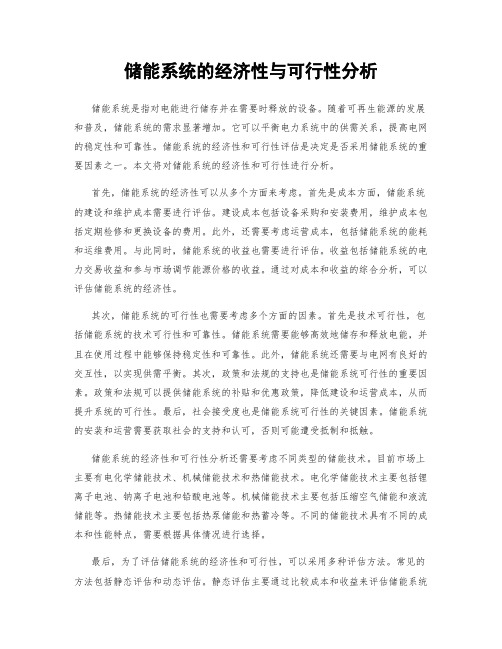
储能系统的经济性与可行性分析储能系统是指对电能进行储存并在需要时释放的设备。
随着可再生能源的发展和普及,储能系统的需求显著增加。
它可以平衡电力系统中的供需关系,提高电网的稳定性和可靠性。
储能系统的经济性和可行性评估是决定是否采用储能系统的重要因素之一。
本文将对储能系统的经济性和可行性进行分析。
首先,储能系统的经济性可以从多个方面来考虑。
首先是成本方面,储能系统的建设和维护成本需要进行评估。
建设成本包括设备采购和安装费用,维护成本包括定期检修和更换设备的费用。
此外,还需要考虑运营成本,包括储能系统的能耗和运维费用。
与此同时,储能系统的收益也需要进行评估。
收益包括储能系统的电力交易收益和参与市场调节能源价格的收益。
通过对成本和收益的综合分析,可以评估储能系统的经济性。
其次,储能系统的可行性也需要考虑多个方面的因素。
首先是技术可行性,包括储能系统的技术可行性和可靠性。
储能系统需要能够高效地储存和释放电能,并且在使用过程中能够保持稳定性和可靠性。
此外,储能系统还需要与电网有良好的交互性,以实现供需平衡。
其次,政策和法规的支持也是储能系统可行性的重要因素。
政策和法规可以提供储能系统的补贴和优惠政策,降低建设和运营成本,从而提升系统的可行性。
最后,社会接受度也是储能系统可行性的关键因素。
储能系统的安装和运营需要获取社会的支持和认可,否则可能遭受抵制和抵触。
储能系统的经济性和可行性分析还需要考虑不同类型的储能技术。
目前市场上主要有电化学储能技术、机械储能技术和热储能技术。
电化学储能技术主要包括锂离子电池、钠离子电池和铅酸电池等。
机械储能技术主要包括压缩空气储能和液流储能等。
热储能技术主要包括热泵储能和热蓄冷等。
不同的储能技术具有不同的成本和性能特点,需要根据具体情况进行选择。
最后,为了评估储能系统的经济性和可行性,可以采用多种评估方法。
常见的方法包括静态评估和动态评估。
静态评估主要通过比较成本和收益来评估储能系统的经济性。
太阳能光热发电和储热的经济性分析报告
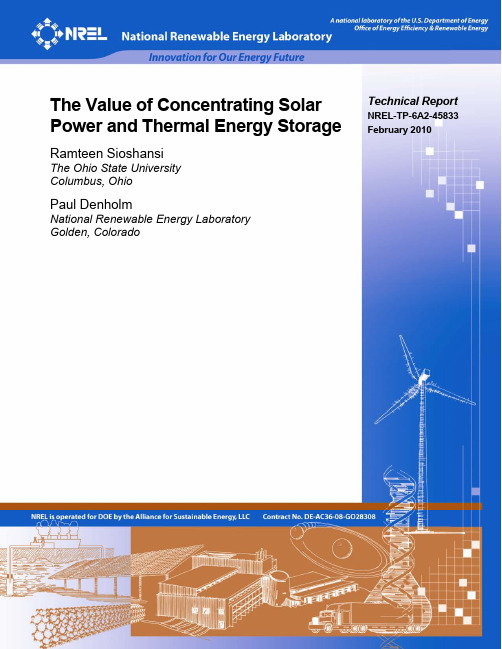
Technical Report NREL-TP-6A2-45833 February 2010The Value of Concentrating Solar Power and Thermal Energy StorageRamteen Sioshansi The Ohio State University Columbus, Ohio Paul Denholm National Renewable Energy Laboratory Golden, ColoradoNational Renewable Energy Laboratory 1617 Cole Boulevard, Golden, Colorado 80401-3393303-275-3000 • NREL is a national laboratory of the U.S. Department of EnergyTechnical Report NREL-TP-6A2-45833 February 2010The Value of Concentrating Solar Power and Thermal Energy Storage Ramteen SioshansiThe Ohio State UniversityColumbus, OhioPaul DenholmNational Renewable Energy LaboratoryGolden, ColoradoPrepared under Task No. CP09.3201NOTICEThis report was prepared as an account of work sponsored by an agency of the United States government. Neither the United States government nor any agency thereof, nor any of their employees, makes any warranty, express or implied, or assumes any legal liability or responsibility for the accuracy, completeness, or usefulness of any information, apparatus, product, or process disclosed, or represents that its use would not infringe privately owned rights. Reference herein to any specific commercial product, process, or service by trade name, trademark, manufacturer, or otherwise does not necessarily constitute or imply its endorsement, recommendation, or favoring by the United States government or any agency thereof. The views and opinions of authors expressed herein do not necessarily state or reflect those of the United States government or any agency thereof.Available electronically at /bridgeAvailable for a processing fee to U.S. Department of Energyand its contractors, in paper, from:U.S. Department of EnergyOffice of Scientific and Technical InformationP.O. Box 62Oak Ridge, TN 37831-0062phone: 865.576.8401fax: 865.576.5728email: mailto:reports@Available for sale to the public, in paper, from:U.S. Department of CommerceNational Technical Information Service5285 Port Royal RoadSpringfield, VA 22161phone: 800.553.6847fax: 703.605.6900email: orders@online ordering: /ordering.htmPrinted on paper containing at least 50% wastepaper, including 20% postconsumer wasteAbstractThis paper examines the value of concentrating solar power (CSP) and thermal energy storage (TES) in four regions in the southwestern United States. Our analysis shows that TES can increase the value of CSP by allowing more thermal energy from a CSP plant’s solar field to be used, by allowing a CSP plant to accommodate a larger solar field, and by allowing CSP generation to be shifted to hours with higher energy prices. We analyze the sensitivity of CSP value to a number of factors, including the optimization period, price and solar forecasting, ancillary service sales, capacity value and dry cooling of the CSP plant. We also discuss the value of CSP plants and TES net of capital costs.Table of ContentsList of Figures (v)List of Tables (v)1Introduction (1)2CSP Model and Simulations (3)3Operating Profits of CSP Plants with TES in Energy-Only Markets (7)4Sensitivity of CSP Profits to Base Case Assumptions (13)4.1Impact of Optimization Horizon (13)4.2Impact of Solar Availability and Energy Price Forecasting (14)4.3Impact of Ancillary Service Sales (15)4.4Impact of Capacity Credit (18)4.5Impact of Power Block Dry Cooling (18)5Break-Even Cost of CSP Plants (21)6Conclusions (24)References (25)List of FiguresFigure 1. Polynomial heat-rate curve in SAM (5)Figure 2. Polynomial representation of HTF parasitics in SAM and piecewise-linearapproximation in dispatch model (6)Figure 3. Polynomial representation of power block parasitics in SAM and piecewise-linear approximation in dispatch model (6)Figure 4. Sample dispatch of a CSP plant with six hours of TES and a solar multiple of 2.0 at Texas site (8)Figure 5: Annual operating profits of a CSP plant at Arizona site (9)Figure 6: Annual operating profits of a CSP plant at Daggett site (9)Figure 7: Annual operating profits of a CSP plant at New Mexico site (10)Figure 8: Annual operating profits of a CSP plant at Texas site (10)Figure 9. Average selling price of energy ($/MWh) and solar field energy wasted (GWh-t) for a CSP plant at Texas site with solar multiple of 2.0 (12)Figure 10. Marginal annual value of each incremental hour of storage for a CSP plant at Texas site with solar multiple of 2.0 (12)Figure 11. Increase in annual operating profits of a CSP plant at Texas site from using weeklong as opposed to daylong optimization period (14)Figure 12. Annual operating profits earned by a CSP plant at Texas site using daily backcasting technique (15)Figure 13. Sample dispatch of a CSP plant with 8 hours of TES and a solar multiple of 2.4 at Texas site when energy and spinning reserve sales are co-optimized (16)Figure 14. Increase in annual operating profits of a CSP plant at the Daggett site if spinning reserves can be sold (17)Figure 15. Increase in annual operating profits of a CSP plant at the Texas site if spinning reserves can be sold (17)Figure 16: Annual operating profit reduction of a dry-cooled CSP plant at Texas site (19)Figure 17. Net operating profits lost from dry- as opposed to wet-cooled CSP plants with a solar multiple of 2.0 (20)Figure 18. Net energy production lost from dry- as opposed to wet-cooled CSP plants with a solar multiple of 2.0 (20)List of TablesTable 1. Location of CSP Plants Studied (4)Table 2: Solar Energy Available and Average Price of Energy for Different CSP Sites (11)Table 3: Year-1 Break-Even Cost and Return on Investment of TES Using Base Case Profit and Cost Assumptions (22)Table 4: Year-1 Break-Even Cost of TES ($ million) with Spinning Reserves Sales and Capacity Credit (22)Table 5: Return on Investment of TES with Spinning Reserves Sales and Capacity Credit and a 10% ITC (23)1 IntroductionRecent and ongoing improvements in thermal solar generation technologies coupled with the need for more renewable sources of energy have increased interest in concentrating solar thermal power (CSP). Unlike solar photovoltaic (PV) generation, CSP uses the thermal energy of sunlight to generate electricity. Two common designs of CSP plants—parabolic troughs and power towers—concentrate sunlight onto a heat-transfer fluid (HTF), which is used to drive a steam turbine. An advantage of CSP over non-dispatchable renewables is that it can be built with thermal energy storage (TES), which can be used to shift generation to periods without solar resource and to provide backup energy during periods with reduced sunlight caused by cloud cover.1Adding TES provides several additional sources of value to a CSP plant. First, unlike a plant that must sell electricity when solar energy is available, a CSP plant with TES can shift electricity production to periods of highest prices. Second, TES may provide firm capacity to the power system, replacing conventional power plants as opposed to just supplementing their output. Finally, the dispatchability of a CSP plant with TES can provide high-value ancillary services such as spinning reserves. The storage medium is typically a molten salt, which has extremely high storage efficiencies in demonstration systems.2Building a CSP plant with TES introduces several sizing options as the plant essentially consists of three independent but interrelated components that can be sized differently: the power block, the solar field, and the thermal storage tank. The size of the power block is the rated power capacity of the steam turbine, and it is typically measured by the rated input of the power block in megawatts of thermal energy (MW-t) or in the rated output of the power block in megawatts of electric energy (MW-e).The size of the solar field, in conjunction with solar irradiance, determines the amount of thermal energy that will be available to the power block. The sizing of the solar field is important because the relative size of the solar field and power block will determine the capacity factor of the CSP plant and the extent to which thermal energy will be wasted. Undersizing the solar field will result in an underused power block and a low capacity factor for the CSP plant, because of the lack of thermal energy during all hours but those with the highest solar resource.3 1 The HTF in a CSP plant will also have some thermal inertia that can help the CSP plant “ride out” a brief reduction in sunlight from a passing cloud. An oversized solar field, on the other hand, will tend to result in thermal energy being wasted because the power block will not have sufficient capacity to use the thermal energy from the solar field in many hours. The size of the solar field can either be measured in the actual area of the field or by using the solar multiple, which normalizes the size of the solar field in terms of the power block size. A solar field with a solar multiple of 1.0 is sized to provide sufficient energy to operate the power block at its rated capacity under reference conditions. The area of a solar field with a higher or lower solar multiple will be scaled linearly; i.e. a field with a solar multiple of 2.0 will cover twice the area of a field with a solar multiple of 1.0.2 This is described in detail in section 4.3.3 A CSP plant can be designed with a fossil-fueled backup system. With such a design, natural gas or another fuel can be used to supplement solar thermal energy. Because our interest is in renewable resources, we focus on a pure CSP plant.The size of storage determines both the thermal power capacity of the heat exchangers between the storage tank and the HTF (measured in MW-t) and the total energy capacity of the storage tank. While the energy capacity of the storage tank can be measured in MWh-t, measuring it in terms of the number of hours of storage is often more convenient. We define the storage capacity as the number of hours that the storage tank can be charged at maximum capacity, which is very similar to the number of hours of discharge capacity because the roundtrip efficiency of the TES is about 98.5%. It is worth noting that another benefit of building a CSP plant with TES is that storage can allow the plant to be built with a larger solar field because excess thermal energy can be placed into storage for use later.For a merchant CSP developer, the decision to build and the choice of the size of a CSP plant will be governed not only by the amount of solar energy available but also by the pattern (coincidence) of solar resource and by electricity prices. Clearly, high electricity prices and an abundance of solar resource are necessary for CSP to be economic, but a lack of correlation between solar availability and electricity prices can make CSP economically unattractive. TES can improve the economics by shifting generation to higher-priced hours, but this adds capital costs and some efficiency losses in the storage cycle.In this paper, we examine the value of adding TES to CSP plants in a number of power systems in the southwestern United States. Using a model that optimally dispatches CSP with TES into existing electricity markets, we examine the potential operating profits (i.e., net revenues from energy sales, not accounting for fixed capital costs) that a CSP plant can earn. We show how these profits vary as a function of plant size. We also show the sensitivity of operating profits to different assumptions, including the possibility of selling ancillary services, the optimization process used, and the use dry rather than wet cooling. We show that while the current cost of CSP technologies make them uneconomic based on energy value alone, addition of TES improves the economics of CSP. We also show that when the value of ancillary services and capacity are taken into account, TES and CSP can be economic even with current technology costs.The remainder of this paper is organized as follows: Section 2 describes our model and the assumptions underlying our analysis. Section 3 presents our analysis of CSP operating profits under the base scenario while Section 4 discusses the sensitivity of those profits to these assumptions. Section 5 discusses the net profitability of TES and CSP plants and Section 6 concludes.2 CSP Model and SimulationsWe model the capabilities and costs of CSP plants using a mixed-integer program (MIP) that is based on the Solar Advisor Model (SAM) developed by the National Renewable Energy Laboratory (NREL)4Unlike SAM, our MIP is formulated to fully optimize the dispatch of a CSP plant to maximize net revenues from energy sales rather than using heuristic rules. SAM is a software package that can model in detail the hourly energy production of PV, concentrating PV, and CSP plants, with different configurations and in different locations. This production data can be coupled with cost data to compute different economic benchmarks for solar systems, such as the levelized cost of energy. SAM also has some capabilities to optimize the dispatch of a CSP plant with TES by using heuristic “time-of-day” type rules. These heuristics can be used to compare the cost of energy from a CSP plant to other conventional generators.5SAM models the three components of a CSP plant—the solar field, TES system, and power block—on an hourly basis, and we use SAM for developing our CSP dispatch model. The solar field model determines the amount of thermal energy (measured in MWh-t) collected by the field that is available to be put into the TES or power block. This available thermal energy is determined by ambient sunlight as well as solar field size and the efficiencies of the components such as concentrators, collectors, and the HTF used in the solar field. We use this hourly available solar data as an input to our model.The dispatch assumes the CSP plant is a price-taking generator that treats prices as fixed. Because we model only a single CSP plant, this price-taking assumption is reasonable, as the operation of the CSP plant would have at most a marginal impact on the dispatch of other generators. The capabilities and costs of the CSP plants are simulated using the baseline CSP system in SAM, which has a wet-cooled power block with a design capacity of 110 MW-e We simulate a set of CSP plant sizes with solar multiples ranging between 1.5 and 2.7 and between zero and twelve hours of TES.We model CSP plants in four different locations, which are summarized in Table 1. The plants were all simulated using energy price and solar data from 2005. The solar data were obtained from NREL’s Renewable Planning Model.6 7 4See Gilman et al. (2008) for a detailed description of SAM and its capabilities. For the Daggett and Texas CSP plants, hourly real-time energy and day-ahead ancillary service price data from their respective wholesale electricity markets were used. In the case of Daggett, price data from the California Independent System Operator (CAISO) SP15 zone is used, whereas the Texas plant uses prices from the Electricity Reliability Council of Texas (ERCOT) western zone. For the locations in Arizona and New Mexico, load lambda data from 2005 for the incumbent utilities—Arizona Public Service (APS) and Public Service New Mexico (PNM), respectively—were used. Load lambda data were obtained from Form 714 filings with the Federal Energy Regulatory Commission. 5 For purposes of comparison, the default heuristic dispatch rule in SAM is able to capture between 87% and 94% of the operating profits that our MIP model earns with a CSP plant with a solar multiple of 2.0 and six hours of TES. 6 Available at / 7 Solar direct normal irradiance in 2005 at the sites we consider was approximately 1-4% below the average over the period 1998-2006.Table 1. Location of CSP Plants StudiedCSP SiteLocation Price Data ArizonaGila Bend, Arizona (32°57’N, 112°57’ W) APS Load Lambda DaggettDaggett, California (34°51’N, 116°51’ W) CAISO SP15 Zone New Mexico Southern New Mexico (31°39’N, 108°39’ W) PNM Load LambdaTexas Western Texas (32°21’N, 102°21’ W) ERCOT West Zone The TES is modeled as a stock and flow system with losses, which accounts for the loss of thermal energy that is kept in storage over time. Furthermore, energy that goes through the storage cycle will experience some additional losses because of inefficiencies in heat transfer from the solar field to the TES and then to the power block. We assume that hourly energy losses in TES will be 0.031%.8The power block is modeled using a heat-rate curve, which gives gross electric output as a function of thermal energy put into the power block. SAM uses a third-order polynomial heat rate curve, which is shown in Figure 1. The figure shows that the polynomial has very little curvature, and for this reason we approximate the curve as a linear function in our dispatch model. As is suggested in the figure, SAM allows the power block to be operated at up to 115% of its design capacity (126.5 MW-e), and we assume that the power block can generate up to this level. We further assume that the power block must be run at a minimum load of 40% of its design point (i.e., gross generation of at least 44 MW-e) whenever the power block is operating. We further require that the power block be online for a minimum of two consecutive hours whenever it is started up, and we assume that 58.3 MWh-t of thermal energy is required to start up the power block, SAM models efficiency losses from using TES by multiplying the gross output of the power block by a term that is a non-linear function of the fraction of thermal energy delivered to the power block that comes from TES. To maintain linearity of our MIP model, we instead assume that 1.5% of energy taken through the storage cycle will be lost—which roughly approximates the non-linear term in SAM. We assume the TES system is sized to allow the power block to operate at its maximum load using energy from storage alone. For the 110 MW-e power block, this corresponds to a power capacity of approximately 340 MW-t. We also assume that the TES system has the same power capacity for charging and discharging.9 8Based on tests conducted of storage efficiencies from the Solar Two CSP plant in California which takes one hour.9 58.3 MWh-t corresponds to 20% of the energy required to run the power block at its design point of 110 MWh-e.Figure 1. Polynomial heat-rate curve in SAMThe output given by the function in Figure 1 is gross electricity production, and does not account for the parasitics of various components in the CSP plant. These parasitics include energy expended for operating the HTF pumps in the TES system, the cooling tower, and balance of plant.1010Parasitics such as HTF pumps are also associated with operating the solar field. These parasitics are already accounted for and are netted out of the hourly thermal energy data we input from SAM into our dispatch model.As with the heat-rate curve, these parasitics are represented as third-order polynomials in SAM. Our model combines cooling tower and balance of plant parasitics into a single power block parasitic. The HTF parasitics are modeled separately because they are a function of the amount of energy taken out of TES, while the other parasitics are a function of gross power block generation. Figures 2 and 3 show the polynomial representation of the parasitics in SAM, as well as the piecewise-linear approximations used in our model. SAM also includes an operating cost estimate of $0.70 per MWh-e generated, which is included in the objective function of the dispatch model.Figure 2. Polynomial representation of HTF parasitics in SAM and piecewise-linear approximation in dispatch modelFigure 3. Polynomial representation of power block parasitics in SAM and piecewise-linear approximation in dispatch model3 Operating Profits of CSP Plants with TES in Energy-OnlyMarketsAs discussed in Section 1, the addition of TES to a CSP plant provides three separate sources of value: energy, capacity, and ancillary services. Our analysis first considers the case of a CSP plant used solely to sell energy into the wholesale market. As discussed in Section 2, we use real-time energy price data from the CAISO and ERCOT market for the Daggett and Texas CSP plants, and we use load lambda data for CSP plants in Arizona and New Mexico, where restructured wholesale markets do not exist. Our analysis first considers the case of a CSP plant operated with perfect foresight of future solar availability and energy prices. Following Sioshansi et al. (2009) the optimization is done one day at a time using a rolling two-day planning horizon. Thus, we assume that dispatch decisions are made one day at a time; however, the next day’s energy prices and solar availability are accounted for in making dispatch decisions each day. This use of a two-day planning horizon ensures that energy in TES at the end of the day has carryover value. Without this use of a two-day optimization horizon, energy would never be kept in TES at the end of a day because it would have no value. Figure 4 shows an example dispatch of a CSP plant at the Texas site with six hours of TES and a solar multiple of 2.0 over the course of a winter day, along with available energy from the solar field and hourly energy prices. The figure shows a typical winter price profile, which has highest demand and prices at the beginning and end of the day. The figure shows that the dispatch follows expected patterns, using energy storage for both the morning and evening demand and price peaks. For instance, in the morning (hours eight through 10) the power block is operated with energy from TES, which was carried over from the previous day to catch the high early-morning prices. The power block is shutdown in hours 15 and 16, when energy prices are relatively low, and the solar field energy is put into TES. The plant then provides energy in the evening peak, using both energy from the solar field and energy from storage.Figure 4. Sample dispatch of a CSP plant with six hours of TES and a solar multipleof 2.0 at Texas siteFigures 5 through 8 show the operating profits of CSP plants with different-sized solar fields and different amounts of TES at the four CSP sites described in Table 1. The figures highlight the fact that the value of a CSP plant can vary significantly by location, with a CSP plant at the Arizona site earning about 60% of the operating profits of the Texas plant. The figures also show how the operating profits vary with plant size. At all of the sites, the value of TES tapers off at about six to eight hours of storage. Moreover, we see that increasing the size of the solar field only yields noticeable profit increases if sufficient TES is available to shift the solar resource toperiods with less available sunlight.Figure 5: Annual operating profits of a CSP plant at Arizona siteFigure 6: Annual operating profits of a CSP plant at Daggett siteFigure 7: Annual operating profits of a CSP plant at New Mexico siteFigure 8: Annual operating profits of a CSP plant at Texas siteBy comparing the average electricity price and the total annual thermal energy produced by different-sized CSP plants, Table 2 shows the underlying cause of the differences in the operating profits of the CSP plants at the different sites. The table shows that the price of energy tends to be more important in determining the profitability of a CSP plant than the amount of solar energy available. Indeed, the Texas site produces the least amount of solar energy, yet the relatively high price of electricity makes it the most profitable site. The table also shows that because of the coincidence of solar insolation with normal load patterns, CSP without TES is between 7% and 35% more valuable than the average price of electricity in the cases evaluated. The table further shows that adding TES increases this value by an additional 7% to 16%.Table 2: Solar Energy Available and Average Price of Energy for Different CSP SitesAverage CSP Selling Price($/MWh) Annual Operating Profits($ million)CSP Site Solar FieldEnergy withSolar Multiple2.0 (GWh-t) AverageEnergy Price($/MWh)11Solar Multiple1.5, No TESSolar Multiple2.0, Six HoursTESSolar Multiple1.5, No TESSolar Multiple2.0, Six HoursTESArizona 1,150 41.2 47.0 50.5 11.6 18.6 Daggett 1,181 55.9 58.5 67.9 14.5 25.0 New Mexico 1,088 57.3 61.2 66.2 13.5 23.0 Texas 961 66.4 89.4 98.4 18.2 30.1The energy-related value of TES is actually derived from two sources. First, TES allows more of the energy collected by the solar field to be used by placing excess energy that would overload the power block into TES for future use, which then allows a larger solar field to be used with a power block. The second value of TES is that it allows generation to be shifted from periods with lower prices to those with higher prices. Figure 9 demonstrates these two effects for a CSP plant in Texas with a solar multiple of 2.0. It shows that as TES is added to the CSP plant, more solar field energy is able to used, with this benefit of TES flattening at about four hours of storage.Moreover, the figure shows that adding TES helps increase the average selling price of energy from the CSP plant, because the TES allows generation to be shifted between hours. This use of TES increases the average selling price of energy from the CSP plant by about $5/MWh with three hours of storage. Figure 10 summarizes these two effects of adding TES to a CSP plant by showing the marginal annual value of each incremental hour of storage. As suggested by Figure 9, the first two hours of TES are highly valuable because of both the generation-shifting and the increased use of solar energy, with the marginal value of storage nearly flattening after eight hours of TES; this is because with this amount of storage the generation-shifting capability of TES has been exhausted and nearly all of the energy from the solar field can be used.11 The average given is the simple average, not a load-weighted average.Figure 9. Average selling price of energy ($/MWh) and solar field energy wasted (GWh-t) for a CSP plant at Texas site with solar multiple of 2.0Figure 10. Marginal annual value of each incremental hour of storage for a CSP plantat Texas site with solar multiple of 2.04 Sensitivity of CSP Profits to Base Case AssumptionsThe results presented thus far represent a base case with a set of assumptions regarding the optimization horizon, perfect foresight of solar availability and energy prices, the markets in which the CSP plant participates, and the availability of water for wet cooling of the power block. We now examine the effect of relaxing these base assumptions on the profitability of CSP and the value of TES.4.1 Impact of Optimization HorizonThe results presented in Section 3 assume that the CSP plant would be dispatched using a rolling one-day optimization period (we also assume that each one-day planning problem would account for the second day). These assumptions allow generation to be shifted between hours within a day, and also allow energy to be stored at the end of each day in anticipation of energy prices the following day. However, these assumptions do not account for the fact that a CSP plant may store energy in anticipation of prices multiple days in the future. For example, Sioshansi et al. (2009) describe a “weekend effect,” in which more energy tends to be stored over weekends in anticipation of higher energy prices on weekdays. Considering this weekend effect, our assumption of a one-day planning horizon may understate the potential profitability of a CSP plant, because it does not fully allow for inter-day generation shifting.We examine the sensitivity of CSP profits by comparing our base case with a one-day planning horizon to one with a rolling one-week planning horizon. As with the one-day model, the weeklong model assumes that the CSP plant has perfect foresight of solar availability and energy prices, and we use an eight-day horizon in the dispatch model to ensure that energy in TES has carryover value at the end of each week. Figure 11 shows the increase in annual operating profits if a CSP plant at the Texas site uses a weeklong planning horizon as opposed to daylong one in its dispatch optimization. The profit increases are given as a percentage of the profits from using a daylong planning period. The figure shows that profits are largely insensitive to the optimization period, with less than a 2.4% increase in profits from switching to a weeklong optimization period, implying that most of the generation shifting with TES is done either within or between adjacent days. The other sites show even less sensitivity to the optimization horizon—with a maximum of between a 1.2% increase in profits from using a weeklong optimization horizon at the Arizona site and a 1.3% increase in profits at the New Mexico site. Also interesting is that the profit increase when using a weeklong optimization period is greatest for a CSP plant configuration with a low solar multiple and more hours of storage. The reason for this result is that with a lower solar multiple, the TES is used less for storing excess solar field energy because there are fewer hours in which the capacity of the power block is binding. Thus, a CSP plant with such a configuration uses TES primarily for shifting generation to higher-priced hours, which will be more sensitive to the planning horizon used.。
太阳能热发电的经济性分析文献综述

太阳能热发电的经济性分析1.研究课题的背景与意义太阳能是一种辐射能,具有即时性,必须即时转换成其它形式能量才能利用和贮存。
而且,作为一种能源,太阳能取之不尽,用之不竭。
一年之中投射到地球的太阳能的能量相当于 137 万亿吨标准煤所产生热量,大约为目前全球一年内利用各种能源所产生能量的两万倍。
而且,太阳能在转换过程中不会产生危及环境的污染。
更为方便的是,太阳能资源遍及全球,可以分散地、区域性地开采。
目前成熟的太阳能发电技术主要有太阳能光热发电、太阳能光伏发电技术两种。
前者是利用光学系统聚集太阳辐射能,用以加热工质产生高温蒸汽,驱动汽轮机发电;后者是通过光电转换直接把光能转化成电能。
作为理想的可再生能源,太阳能具有“取之不尽,用之不竭”的特点,利用太阳能发电具有环保等优点,而且不必考虑其安全性问题,只要有阳光的地方都可以利用太阳能。
目前,全球正面临着气候变暖和社会发展两大课题,以石油为代表的化石能源日益枯竭,价格大幅波动。
经济发展消耗大量的化石燃料,导致温室气体排放量快速增长。
因此各国政府十分重视太阳能发电的研究,纷纷制定有关法规和相关鼓励政策,促进了太阳能发电技术发展。
经过几十年的探讨和发展,在欧美一些发达国家初步实现了太阳能发电的产业化,促进太阳能发电技术的发展。
太阳能总量巨大,是使用不会枯竭的能源;没有影响环境的排泄物,是最清洁的能源;不集中在某个地方,是在整个地球上都可以利用的能源。
我国的太阳能资源比较丰富且分布范围较广,太阳能光伏发电的发展潜力巨大。
在太阳能、风能、生物质能、潮汐能等各类可再生能源中,太阳能成为发电首选。
不管从资源的数量、分布的普遍性,还是从清洁性、技术的可靠性来看,太阳能都比其它可再生能源更具有优越性。
太阳能发电技术主要包括太阳能光伏发电和太阳能热发电两种,当前这两种技术虽然均有商业化的业绩,但投资大、成本高仍然是影响太阳能发电技术规模化应用的主要障碍。
其中太阳能光伏发电的缺点更为明显1)照射的能量分布密度小,即要占用巨大面积;2)获得的能源同四季、昼夜及阴晴等气象条件有关;3)价格昂贵。
太阳能集热器经济效益分析(计算过程)
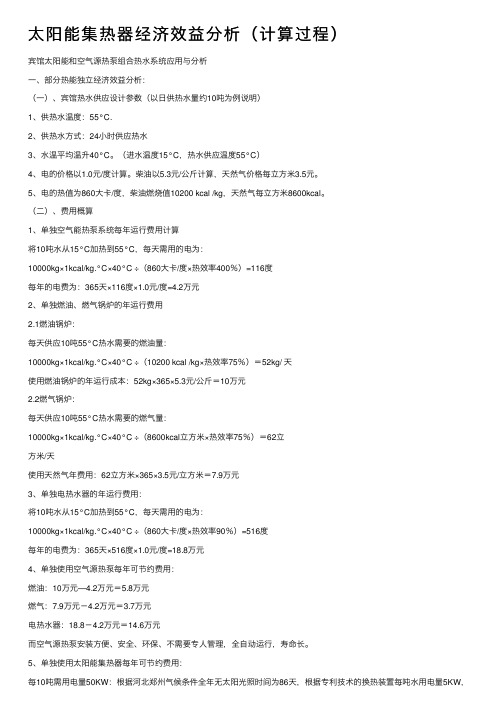
太阳能集热器经济效益分析(计算过程)宾馆太阳能和空⽓源热泵组合热⽔系统应⽤与分析⼀、部分热能独⽴经济效益分析:(⼀)、宾馆热⽔供应设计参数(以⽇供热⽔量约10吨为例说明)1、供热⽔温度:55°C.2、供热⽔⽅式:24⼩时供应热⽔3、⽔温平均温升40°C。
(进⽔温度15°C,热⽔供应温度55°C)4、电的价格以1.0元/度计算。
柴油以5.3元/公⽄计算,天然⽓价格每⽴⽅⽶3.5元。
5、电的热值为860⼤卡/度,柴油燃烧值10200 kcal /kg,天然⽓每⽴⽅⽶8600kcal。
(⼆)、费⽤概算1、单独空⽓能热泵系统每年运⾏费⽤计算将10吨⽔从15°C加热到55°C,每天需⽤的电为:10000kg×1kcal/kg.°C×40°C ÷(860⼤卡/度×热效率400%)=116度每年的电费为:365天×116度×1.0元/度=4.2万元2、单独燃油、燃⽓锅炉的年运⾏费⽤2.1燃油锅炉:每天供应10吨55°C热⽔需要的燃油量:10000kg×1kcal/kg.°C×40°C ÷(10200 kcal /kg×热效率75%)=52kg/ 天使⽤燃油锅炉的年运⾏成本:52kg×365×5.3元/公⽄=10万元2.2燃⽓锅炉:每天供应10吨55°C热⽔需要的燃⽓量:10000kg×1kcal/kg.°C×40°C ÷(8600kcal⽴⽅⽶×热效率75%)=62⽴⽅⽶/天使⽤天然⽓年费⽤:62⽴⽅⽶×365×3.5元/⽴⽅⽶=7.9万元3、单独电热⽔器的年运⾏费⽤:将10吨⽔从15°C加热到55°C,每天需⽤的电为:10000kg×1kcal/kg.°C×40°C ÷(860⼤卡/度×热效率90%)=516度每年的电费为:365天×516度×1.0元/度=18.8万元4、单独使⽤空⽓源热泵每年可节约费⽤:燃油:10万元—4.2万元=5.8万元燃⽓:7.9万元-4.2万元=3.7万元电热⽔器:18.8-4.2万元=14.6万元⽽空⽓源热泵安装⽅便、安全、环保、不需要专⼈管理,全⾃动运⾏,寿命长。
光伏发电项目的技术和经济性分析

光伏发电项目的技术和经济性分析摘要:第一次工业革命、第二次工业革命都消耗了大量化石能源。
现阶段,全球发展依然对化石能源有较强的依赖性,在过度开采化石能源的过程中,环境受到威胁,也对社会的发展造成了阻碍,因此人类不得不重视对生态环境的保护。
在我国“双碳”战略目标的实现过程中,开发与使用清洁能源成为重要手段,太阳能光伏发电等清洁能源技术已成为全球经济发展的可靠保障。
本文以分布式光伏发电项目为例,探讨项目的成本效益,并对其推广方式进行了分析,希望能够以此方式来进一步加快我国节能建设工作的开展,并且也能在项目落实的过程中,通过此工作的运行来为国家能源保护工作做贡献。
关键词:光伏发电项目;技术分析;经济性分析光伏发电是较为清洁的发电方式,所采用的为可再生的太阳能,和传统的化石能源相比具有明显的优势,近年来在电力系统中的装机容量不断扩大,在电力系统中已经具有较高的电量占比。
分布式光伏发电技术指的是在进行目标锁定后,根据目标所在地来实现对电能的就地利用,而且它能通过低电压入户来实现对光伏发电项目的应用,这是当前有效的节约电能方式。
同时,该发电系统通常会与建筑物进行结合,也就是当前主要推广的屋顶节能技术,并且在细分的过程中,该技术具有一体化项目的应用效果,因此它的应用能够在节约电能的同时,为各家各户送去电能进行应用,并通过对能源的有效保障来进一步优化电能的应用效率,这样就能减少能源浪费现象。
该技术的应用能够有效确保我国可持续发展战略的落实,并且也能为相关企业带来经济效益的提升,有利于促进我国国民经济的增长。
1.光伏发电项目概述在光伏发电项目中,光伏电站中主要的设备为光伏电池板,汇控柜、变电设备等。
电网企业对光伏并网的条件有了明确的规定,只有当光伏电站满足要求时,才允许其并网运行。
光伏发电项目在技术方面,涉及到光伏电站的装机容量是否满足实际要求,光伏发电系统所配备的无功补偿、电能质量、保护装置、通信设备和自动化装置等是否满足并网的要求。
太阳能热利用技术的经济性与可行性分析

太阳能热利用技术的经济性与可行性分析1. 引言太阳能热利用技术是一种环保、可再生能源利用方式,近年来备受关注。
本文将对太阳能热利用技术的经济性与可行性展开深入分析,探讨其在目前社会背景下的发展前景。
2. 太阳能热利用技术的基本原理太阳能热利用技术是利用太阳能热量来提供热水、采暖等用途的一种技术。
其基本原理是通过太阳能集热器将太阳能转化为热能,然后通过热交换器传递到热载体中,最终实现能源利用。
这种技术不仅可以减少对传统能源的依赖,还能减少二氧化碳等温室气体的排放,对环境友好。
3. 太阳能热利用技术的经济性分析在当前环境问题日益严峻的大背景下,太阳能热利用技术的经济性备受关注。
首先,太阳能是一种免费的能源来源,相比于传统的化石能源,太阳能的成本更低廉。
其次,太阳能热利用技术在运行过程中几乎不需要额外的能源投入,所以维护成本也很低。
再者,太阳能热利用技术可通过相关部门补贴等方式获得一定的资金支持,使得投资回报更为可观。
因此,从经济角度出发,太阳能热利用技术具有较高的投资回报率,是一种值得推广的技术。
4. 太阳能热利用技术的可行性分析除了经济性,太阳能热利用技术在可行性方面也有许多优势。
首先,太阳能是一种广泛分布的能源,几乎全球各地都可以利用太阳能进行热能转换。
其次,太阳能热利用技术具有一定的适用性,不论是家庭还是工业用途,都能够满足需求。
再者,太阳能热利用技术具有良好的环保性,不会对环境造成污染,有助于改善大气质量和缓解能源危机。
因此,从可行性角度出发,太阳能热利用技术具有广泛的应用前景。
5. 太阳能热利用技术在不同领域的应用太阳能热利用技术在不同领域都有着广泛的应用。
在家庭方面,太阳能热水器可以替代传统的燃气热水器,降低生活成本同时保护环境。
在工业领域,太阳能热利用技术可以用于产生蒸汽、供暖等用途,为企业节约能源成本。
此外,太阳能热利用技术还可以应用于农业、温室大棚等领域,提高生产效率,减少对化肥等化学品的依赖,有利于农业可持续发展。
主要储能系统技术经济性分析报告
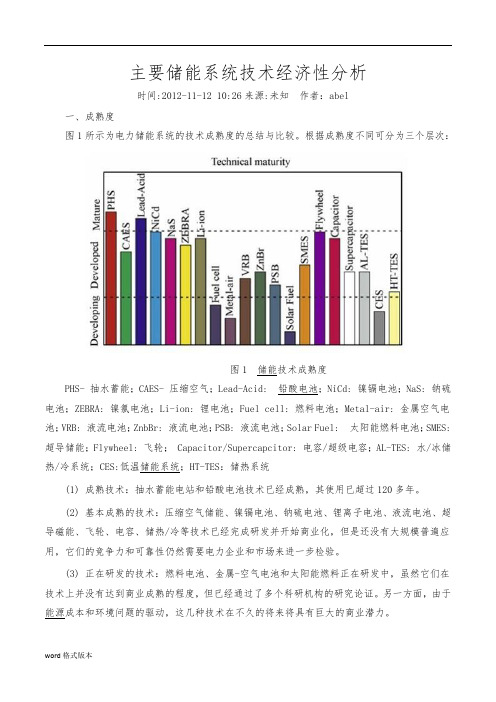
主要储能系统技术经济性分析时间:2012-11-12 10:26来源:未知作者:abel一、成熟度图1所示为电力储能系统的技术成熟度的总结与比较。
根据成熟度不同可分为三个层次:图1 储能技术成熟度PHS- 抽水蓄能;CAES- 压缩空气;Lead-Acid: 铅酸电池;NiCd: 镍镉电池;NaS: 钠硫电池;ZEBRA: 镍氯电池;Li-ion: 锂电池;Fuel cell: 燃料电池;Metal-air: 金属空气电池;VRB: 液流电池;ZnbBr: 液流电池;PSB: 液流电池;Solar Fuel: 太阳能燃料电池;SMES: 超导储能;Flywheel: 飞轮; Capacitor/Supercapcitor: 电容/超级电容;AL-TES: 水/冰储热/冷系统;CES:低温储能系统;HT-TES:储热系统(1) 成熟技术:抽水蓄能电站和铅酸电池技术已经成熟,其使用已超过120多年。
(2) 基本成熟的技术:压缩空气储能、镍镉电池、钠硫电池、锂离子电池、液流电池、超导磁能、飞轮、电容、储热/冷等技术已经完成研发并开始商业化,但是还没有大规模普遍应用,它们的竞争力和可靠性仍然需要电力企业和市场来进一步检验。
(3) 正在研发的技术:燃料电池、金属-空气电池和太阳能燃料正在研发中,虽然它们在技术上并没有达到商业成熟的程度,但已经通过了多个科研机构的研究论证。
另一方面,由于能源成本和环境问题的驱动,这几种技术在不久的将来将具有巨大的商业潜力。
二、功率和放电时间表1对各种类型电力储能系统的功率和放电时间进行了比较,根据它们的应用情况,大体上分为三种类型:(1) 能源管理:抽水储能、压缩空气储能适合于规模超过100MW和能够实现每天持续输出的应用,可用于大规模的能源管理,如负载均衡、输出功率斜坡/负载跟踪。
大型电池、液流电池、燃料电池、太阳能电池和储热/冷适合于10~100MW的中等规模能源管理。
当前储能市场和储能经济性分析
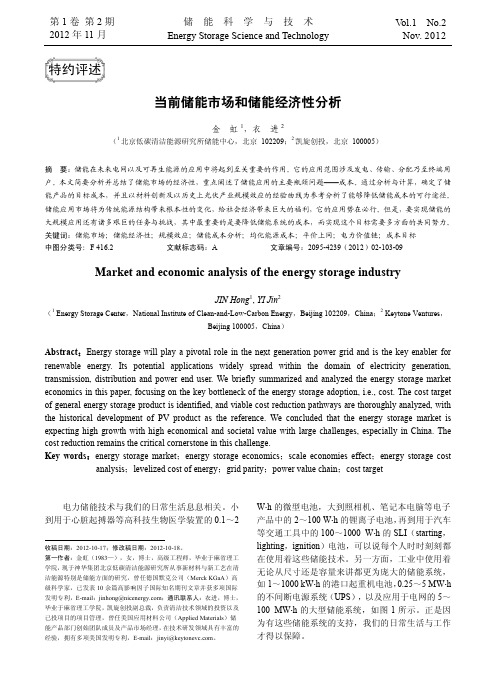
第1卷第2期 2012年11月 储 能 科 学 与 技 术 Energy Storage Science and Technology V ol.1 No.2Nov. 2012特约评述当前储能市场和储能经济性分析金 虹1,衣 进2(1北京低碳清洁能源研究所储能中心,北京 102209;2凯旋创投,北京 100005)摘 要:储能在未来电网以及可再生能源的应用中将起到至关重要的作用。
它的应用范围涉及发电、传输、分配乃至终端用户。
本文简要分析并总结了储能市场的经济性,重点阐述了储能应用的主要瓶颈问题——成本。
通过分析与计算,确定了储能产品的目标成本,并且以材料创新及以历史上光伏产业规模效应的经验曲线为参考分析了能够降低储能成本的可行途径。
储能应用市场将为传统能源结构带来根本性的变化,给社会经济带来巨大的福利,它的应用势在必行。
但是,要实现储能的大规模应用还有诸多艰巨的任务与挑战,其中最重要的是要降低储能系统的成本,而实现这个目标需要多方面的共同努力。
关键词:储能市场;储能经济性;规模效应;储能成本分析;均化能源成本;平价上网;电力价值链;成本目标 中图分类号:F 416.2 文献标志码:A 文章编号:2095-4239(2012)02-103-09Market and economic analysis of the energy storage industryJIN Hong 1, YI Jin 2(1 Energy Storage Center ,National Institute of Clean-and-Low-Carbon Energy ,Beijing 102209,China ;2 Keytone Ventures ,Beijing 100005,China )Abstract :Energy storage will play a pivotal role in the next generation power grid and is the key enabler for renewable energy. Its potential applications widely spread within the domain of electricity generation, transmission, distribution and power end user. We briefly summarized and analyzed the energy storage market economics in this paper, focusing on the key bottleneck of the energy storage adoption, i.e., cost. The cost target of general energy storage product is identified, and viable cost reduction pathways are thoroughly analyzed, with the historical development of PV product as the reference. We concluded that the energy storage market is expecting high growth with high economical and societal value with large challenges, especially in China. The cost reduction remains the critical cornerstone in this challenge.Key words :energy storage market ;energy storage economics ;scale economies effect ;energy storage costanalysis ;levelized cost of energy ;grid parity ;power value chain ;cost target电力储能技术与我们的日常生活息息相关。
太阳能发电系统经济性评估和投资回报分析

太阳能发电系统经济性评估和投资回报分析随着能源危机的日益严重,太阳能发电作为一种清洁、可再生的能源形式,受到了越来越多的关注。
然而,投资太阳能发电系统需要考虑到经济性评估和投资回报分析,以确保投资的可行性和回报。
一、经济性评估太阳能发电系统的经济性评估主要包括成本和效益两个方面。
首先,我们需要考虑到系统的建设成本,包括太阳能电池板、逆变器、电池储能装置等设备的购置和安装费用。
此外,还需要考虑到系统的运维成本,包括设备维护、电池更换等费用。
这些成本需要与系统的预期寿命进行比较,以评估系统的经济性。
其次,我们需要考虑到太阳能发电系统的效益。
太阳能发电系统可以将太阳能转化为电能,为用户提供电力供应。
与传统的电力供应方式相比,太阳能发电系统具有环保、可再生的特点,可以减少对化石能源的依赖,并减少对环境的污染。
此外,太阳能发电系统还可以通过卖电上网,将多余的电能卖给电力公司,从而获得额外的收入。
这些效益需要与系统的成本进行综合评估,以确定系统的经济性。
二、投资回报分析投资回报分析是评估太阳能发电系统投资的回报情况,主要包括投资回收期、净现值和内部收益率等指标。
首先,我们需要计算太阳能发电系统的投资回收期,即从投资开始到回收全部投资的时间。
投资回收期越短,说明投资回报越快,系统的经济性越好。
其次,我们需要计算太阳能发电系统的净现值,即将未来的收益折现到现在的价值。
净现值越大,说明系统的投资回报越高,经济性越好。
同时,我们还需要计算太阳能发电系统的内部收益率,即使得净现值为零的贴现率。
内部收益率越高,说明系统的投资回报越高,经济性越好。
除了以上指标,我们还可以考虑太阳能发电系统的风险情况。
太阳能发电系统的投资回报受到多种因素的影响,包括太阳能资源、电力市场价格等。
因此,我们需要进行风险分析,评估系统的风险情况,并制定相应的风险管理策略,以确保投资的安全性和回报。
三、结论综上所述,太阳能发电系统的经济性评估和投资回报分析是投资者在选择太阳能发电系统时需要考虑的重要因素。
太阳能光热电站储能系统热性能研究及技术经济分析

采用理论分析、数值模拟和实验研究相结合的方法,对太阳能光热电站储能系统的热性能进行全面分析和评估 。具体包括:建立储能系统的数学模型,进行模拟分析;通过实验测试,验证模拟结果的准确性;针对现有问 题提出优化方案和技术改进措施;最后进行技术经济分析,评估优化方案的经济效益和可行性。
02
太阳能光热电站概述
太阳能光热电站工作原理01 Nhomakorabea02
03
聚光吸热
通过反射镜将太阳光聚集 到集热器上,加热集热器 中的工质,使其产生高温 高压的蒸汽。
热力循环
蒸汽驱动汽轮机进行热力 循环,将热能转化为机械 能,带动发电机发电。
冷凝放热
蒸汽在汽轮机中膨胀做功 后,冷凝成水,放出热量 ,形成热循环。
太阳能光热电站系统组成
聚光系统
提高储能系统经济性的优化策略
选用低成本储能介质
选择成本较低的储能介质,如熔盐、导热油等,降低储能系统的 初始投资成本。
实施生命周期成本管理
在设计和建设阶段考虑储能系统的生命周期成本,通过延长储能 设备使用寿命和降低维护成本,提高经济性。
结合可再生能源使用
将储能系统与可再生能源(如风能、太阳能)相结合使用,提高 能源利用效率,降低运行成本。
《太阳能光热电站 储能系统热性能研 究及技术经济分析 》
2023-10-30
目录
• 引言 • 太阳能光热电站概述 • 储能系统热性能研究 • 技术经济分析 • 太阳能光热电站储能系统优化策
略及建议 • 结论与展望
01
引言
研究背景与意义
01
太阳能光热电站是新能源领域 的重要发展方向,而储能系统 是其中的核心技术之一。
不同储能技术的经济性比较分析
太阳能热发电的经济性分析
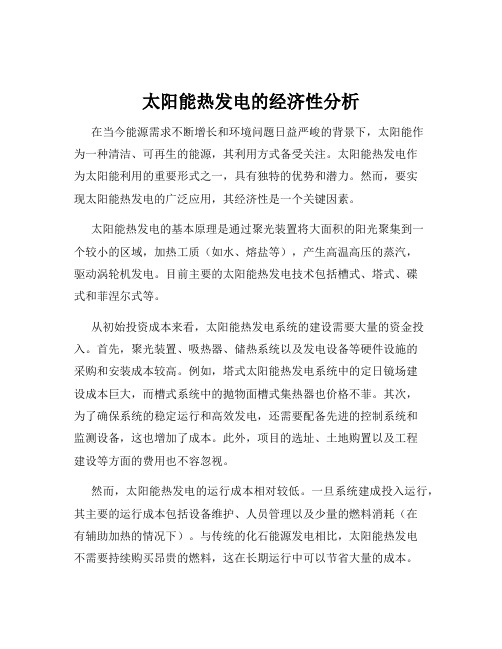
太阳能热发电的经济性分析在当今能源需求不断增长和环境问题日益严峻的背景下,太阳能作为一种清洁、可再生的能源,其利用方式备受关注。
太阳能热发电作为太阳能利用的重要形式之一,具有独特的优势和潜力。
然而,要实现太阳能热发电的广泛应用,其经济性是一个关键因素。
太阳能热发电的基本原理是通过聚光装置将大面积的阳光聚集到一个较小的区域,加热工质(如水、熔盐等),产生高温高压的蒸汽,驱动涡轮机发电。
目前主要的太阳能热发电技术包括槽式、塔式、碟式和菲涅尔式等。
从初始投资成本来看,太阳能热发电系统的建设需要大量的资金投入。
首先,聚光装置、吸热器、储热系统以及发电设备等硬件设施的采购和安装成本较高。
例如,塔式太阳能热发电系统中的定日镜场建设成本巨大,而槽式系统中的抛物面槽式集热器也价格不菲。
其次,为了确保系统的稳定运行和高效发电,还需要配备先进的控制系统和监测设备,这也增加了成本。
此外,项目的选址、土地购置以及工程建设等方面的费用也不容忽视。
然而,太阳能热发电的运行成本相对较低。
一旦系统建成投入运行,其主要的运行成本包括设备维护、人员管理以及少量的燃料消耗(在有辅助加热的情况下)。
与传统的化石能源发电相比,太阳能热发电不需要持续购买昂贵的燃料,这在长期运行中可以节省大量的成本。
太阳能热发电的经济性还受到诸多因素的影响。
其一,太阳能资源的丰富程度和稳定性直接关系到发电效率和成本。
在太阳能资源丰富的地区,如沙漠地区,日照时间长、强度高,能够为热发电系统提供充足的能量,从而提高发电效率,降低单位成本。
相反,在太阳能资源不稳定的地区,可能需要配备更多的储热设施或其他辅助能源,以保障电力供应的稳定性,这会增加成本。
其二,技术进步对太阳能热发电的经济性有着重要的推动作用。
随着材料科学、制造工艺和系统设计的不断改进,太阳能热发电设备的效率不断提高,成本逐渐降低。
例如,新型的吸热材料能够提高吸热效率,更高效的储热技术能够延长发电时间,从而提高系统的整体经济性。
太阳能光热发电的经济性评估
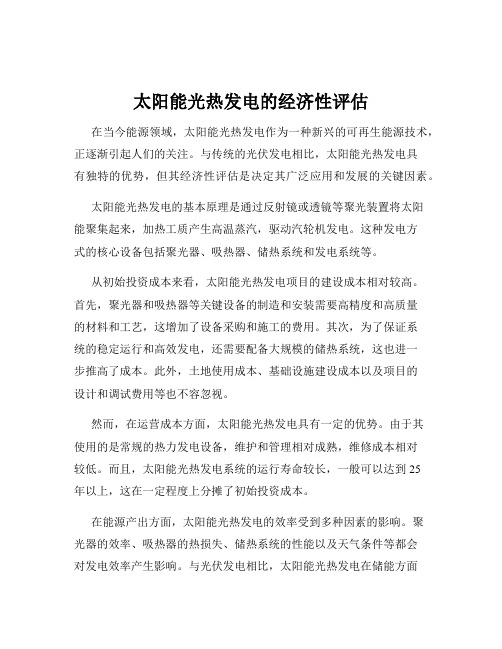
太阳能光热发电的经济性评估在当今能源领域,太阳能光热发电作为一种新兴的可再生能源技术,正逐渐引起人们的关注。
与传统的光伏发电相比,太阳能光热发电具有独特的优势,但其经济性评估是决定其广泛应用和发展的关键因素。
太阳能光热发电的基本原理是通过反射镜或透镜等聚光装置将太阳能聚集起来,加热工质产生高温蒸汽,驱动汽轮机发电。
这种发电方式的核心设备包括聚光器、吸热器、储热系统和发电系统等。
从初始投资成本来看,太阳能光热发电项目的建设成本相对较高。
首先,聚光器和吸热器等关键设备的制造和安装需要高精度和高质量的材料和工艺,这增加了设备采购和施工的费用。
其次,为了保证系统的稳定运行和高效发电,还需要配备大规模的储热系统,这也进一步推高了成本。
此外,土地使用成本、基础设施建设成本以及项目的设计和调试费用等也不容忽视。
然而,在运营成本方面,太阳能光热发电具有一定的优势。
由于其使用的是常规的热力发电设备,维护和管理相对成熟,维修成本相对较低。
而且,太阳能光热发电系统的运行寿命较长,一般可以达到 25年以上,这在一定程度上分摊了初始投资成本。
在能源产出方面,太阳能光热发电的效率受到多种因素的影响。
聚光器的效率、吸热器的热损失、储热系统的性能以及天气条件等都会对发电效率产生影响。
与光伏发电相比,太阳能光热发电在储能方面具有优势,可以在夜间或阴天继续发电,从而提高了能源的利用率和稳定性。
对于太阳能光热发电的经济性评估,还需要考虑政策和市场环境的影响。
在许多国家和地区,为了推动可再生能源的发展,政府出台了一系列的优惠政策,如补贴、税收减免等。
这些政策在一定程度上降低了太阳能光热发电的成本,提高了其在市场上的竞争力。
此外,随着技术的不断进步,太阳能光热发电的成本也在逐渐降低。
一方面,关键设备的制造工艺不断改进,规模化生产降低了设备成本;另一方面,系统的优化设计和运行管理水平的提高也有助于提高发电效率和降低运营成本。
在评估太阳能光热发电的经济性时,还需要与其他能源形式进行比较。
混凝土桩储热技术研究及经济性分析
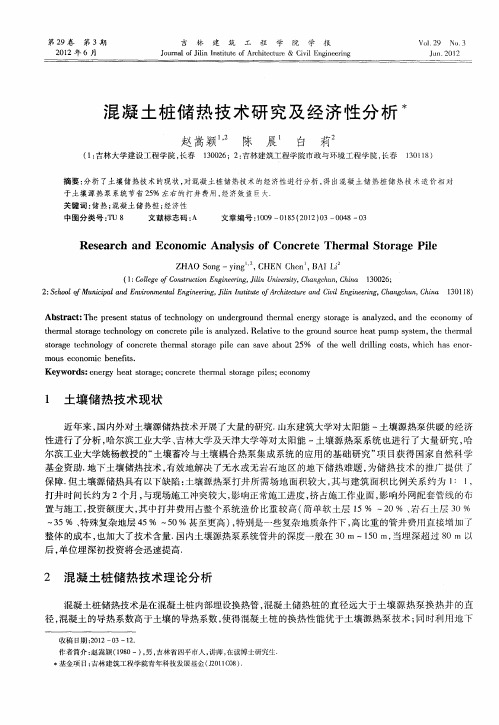
性进 行 了分 析 , 哈尔滨 工业 大学 、 吉林 大学 及天津 大学 等对 太 阳能 一 壤源 热 泵 系统 也进 行 了大 量研 究 , 土 哈 尔滨 工业 大学 姚 杨教 授 的“ 土壤 蓄冷 与土 壤耦 合 热泵 集 成 系统 的应 用 的基 础 研 究 ” 目获得 国家 自然科 学 项 基 金 资助 . 下 土壤储 热技 术 , 效地 解决 了无水 或无 岩石 地 区 的地 下 储 热难题 , 地 有 为储 热 技术 的推 广 提 供 r 保 障. 土壤 源储 热具 有 以下缺 陷 : 但 土壤源 热泵 打井 所 需 场地 面 积较 大 , 与 建筑 面 积 比例 关 系 约 为 1 1 其 : ,
Jn 2 2 u . 01
混 凝 土桩储 热 技 术研 究 及 经济 性 分 析 术
赵 嵩颖
(: 1 吉林 大学建设 工程学院 , 长春
陈 晨 白 莉
10 1 ) 3 t8
10 2 ;2: 30 6 吉林建筑工程学 院市政与环境工程学院 , 长春
摘 要 : 析 了土壤 储 热技 术 的 现 状 , 混 凝 土 桩 储 热 技 术 的 经 济 性进 行 分 析 , 出 混 凝 土 储 热桩 储 热 技 术 造 价 相 对 分 对 得 干 土 壤 源 热 泵 系统 节 省 2 % 左 右 的打 井费 用 , 5 经济 效 益 巨 大. 关 键 词 : 热 ; 凝 土 储 热 桩 ; 济 性 储 混 经 中 图 分 类 号 :u 8 T 文 献 标 志 码 : A 文 章 编 号 :09— 15 2 1 )3—04 0 10 0 8 (02 0 0 8— 3
太阳能集热器经济效益和环境效益分析

效益分析工程经济、效益分析随着国家环保政策的日益规范和人们环保意识的日益增强,燃煤锅炉的使用受到越来越多的限制。
很多地方已经禁用燃煤锅炉,由此导致一些用水量较少的单位不得不采用燃油(气)锅炉,而日益高涨的油(气)价使这些单位不堪重负。
在此背景下,太阳能热水工程环保、节能、安全、方便的优点充分显示出来。
下面以该工程为例计算太阳能热水系统的效益分析,该工程所需的太阳能工程为90㎡。
(一)、经济效益分析:1.基础参数1)1㎡太阳能按3.5度电计算;2)一年按280天计算;3)若以60年为参照;4)1度电以0.6元计算。
2.根据以上已知基础参数计算得:1㎡太阳能每年节约费用为:3.5*280*0.6=588元;所以1㎡太阳能集热器年节能为588元/㎡;综上所述:本项目总共配置太阳能集热器90㎡,年总节能为588元/㎡×90㎡=52920元约计5万元(二)、环境效益分析1㎡太阳能集热器一年可以节约标煤250㎏;则减少的二氧化碳数量为:250*44/12=917㎏;该项目90㎡一年可以节约标煤22.5吨、减少82.53吨二氧化碳的排放。
对改善环境,保护人们生命建康有着更长远的效益。
综上所说,该项目具有相当可观的经济效益和社会效益、环境效益,可谓功在当今,利在子孙。
太阳能是绿色能源中最重要的能源,是取之不尽、用之不竭、广泛存在的天然能源,其优点是极为丰富、洁净、安全、价廉,对生态平衡没有任何影响。
建筑节能直接关系到国家资源战略、可持续发展和环境保护,是建筑业一项重要、紧迫而又艰苦的任务,应值得全社会重视,北方地区能耗较大,推广和使用节能建筑必将产生较好的经济和社会效益。
采暖是一种经济效益和社会效益都非常好的采暖热源形式,它不仅能够解决污染问题,提高供热质量而且是谷期用电降低了运行成本,提高了电网效率,起到了“移峰填谷”的作用,提高了电力系统经济效益。
综合采用多种节能措施,才能达到更好的节能效果。
(三)、项目效益分析汇总表序号效益要素1年60年1集热面积2节约电能4节约标煤5减排。
分布式光伏电站与储能技术方案及经济性探讨
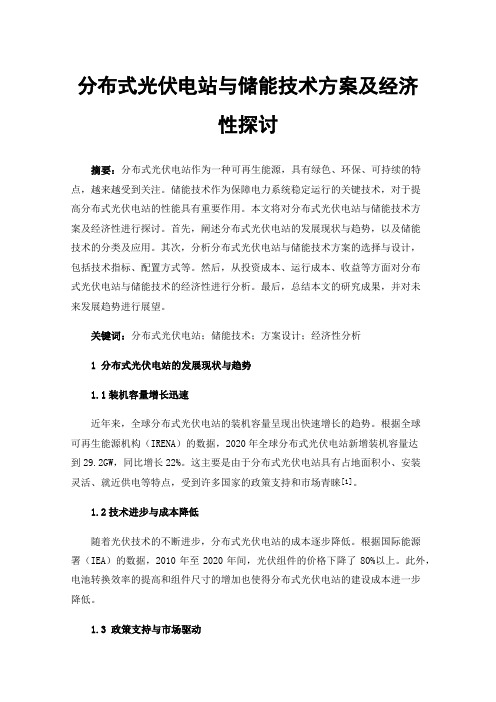
分布式光伏电站与储能技术方案及经济性探讨摘要:分布式光伏电站作为一种可再生能源,具有绿色、环保、可持续的特点,越来越受到关注。
储能技术作为保障电力系统稳定运行的关键技术,对于提高分布式光伏电站的性能具有重要作用。
本文将对分布式光伏电站与储能技术方案及经济性进行探讨。
首先,阐述分布式光伏电站的发展现状与趋势,以及储能技术的分类及应用。
其次,分析分布式光伏电站与储能技术方案的选择与设计,包括技术指标、配置方式等。
然后,从投资成本、运行成本、收益等方面对分布式光伏电站与储能技术的经济性进行分析。
最后,总结本文的研究成果,并对未来发展趋势进行展望。
关键词:分布式光伏电站;储能技术;方案设计;经济性分析1分布式光伏电站的发展现状与趋势1.1装机容量增长迅速近年来,全球分布式光伏电站的装机容量呈现出快速增长的趋势。
根据全球可再生能源机构(IRENA)的数据,2020年全球分布式光伏电站新增装机容量达到29.2GW,同比增长22%。
这主要是由于分布式光伏电站具有占地面积小、安装灵活、就近供电等特点,受到许多国家的政策支持和市场青睐[1]。
1.2技术进步与成本降低随着光伏技术的不断进步,分布式光伏电站的成本逐步降低。
根据国际能源署(IEA)的数据,2010年至2020年间,光伏组件的价格下降了80%以上。
此外,电池转换效率的提高和组件尺寸的增加也使得分布式光伏电站的建设成本进一步降低。
1.3政策支持与市场驱动许多国家纷纷出台政策支持分布式光伏电站的发展。
例如,中国政府推出了一系列支持分布式光伏电站建设的政策,包括度电补贴、分布式光伏发电市场化交易等。
此外,随着能源价格的上涨和环境意识的增强,越来越多的企业和家庭开始选择投资分布式光伏电站,以实现节能减排和降低能源成本。
1.4储能技术的应用随着分布式光伏电站的普及,储能技术在提高电站性能方面的作用日益凸显。
通过配置储能设备,可以实现电力的存储和释放,从而提高电站的稳定性和电力质量。
太阳能光热发电系统的性能经济与环境评估研究
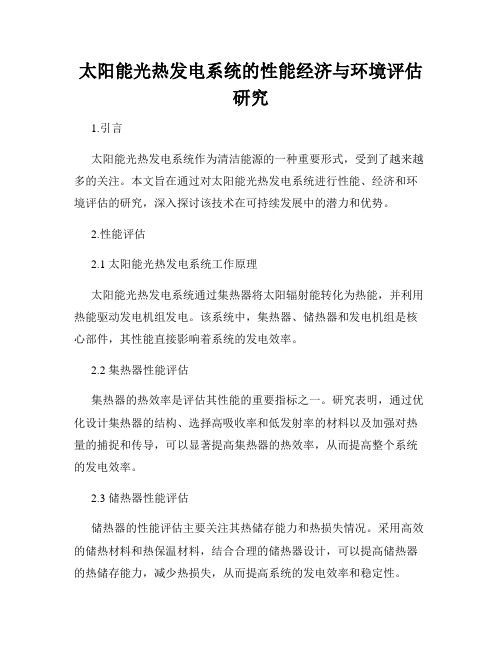
太阳能光热发电系统的性能经济与环境评估研究1.引言太阳能光热发电系统作为清洁能源的一种重要形式,受到了越来越多的关注。
本文旨在通过对太阳能光热发电系统进行性能、经济和环境评估的研究,深入探讨该技术在可持续发展中的潜力和优势。
2.性能评估2.1 太阳能光热发电系统工作原理太阳能光热发电系统通过集热器将太阳辐射能转化为热能,并利用热能驱动发电机组发电。
该系统中,集热器、储热器和发电机组是核心部件,其性能直接影响着系统的发电效率。
2.2 集热器性能评估集热器的热效率是评估其性能的重要指标之一。
研究表明,通过优化设计集热器的结构、选择高吸收率和低发射率的材料以及加强对热量的捕捉和传导,可以显著提高集热器的热效率,从而提高整个系统的发电效率。
2.3 储热器性能评估储热器的性能评估主要关注其热储存能力和热损失情况。
采用高效的储热材料和热保温材料,结合合理的储热器设计,可以提高储热器的热储存能力,减少热损失,从而提高系统的发电效率和稳定性。
2.4 发电机组性能评估发电机组的性能评估主要包括电能转化效率和可靠性评估两个方面。
为提高电能转化效率,需优化发电机组的设计和运行参数,并选择高效率的发电机组。
同时,对发电机组进行严格的可靠性评估,确保系统在长期运行中能够稳定可靠地发电。
3.经济评估3.1 太阳能光热发电系统成本太阳能光热发电系统的成本主要包括设备采购成本、安装调试成本、运行维护成本和电网接入成本等。
通过合理规划和设计,选择性价比高的设备和材料,优化项目管理和运营,可以降低系统的成本。
3.2 太阳能光热发电系统收益太阳能光热发电系统的收益主要来自电力销售收入和政府的补贴政策。
针对不同地区和市场条件,制定合理的电价政策和补贴政策,以确保系统的经济可行性和回报率。
3.3 投资回报率评估通过对系统的成本和收益进行分析,计算投资回收期和净现值等财务指标,可对太阳能光热发电系统的经济效益进行评估。
在评估结果中,需要考虑项目的可持续性和长期发展前景,为投资者提供合理的决策依据。
- 1、下载文档前请自行甄别文档内容的完整性,平台不提供额外的编辑、内容补充、找答案等附加服务。
- 2、"仅部分预览"的文档,不可在线预览部分如存在完整性等问题,可反馈申请退款(可完整预览的文档不适用该条件!)。
- 3、如文档侵犯您的权益,请联系客服反馈,我们会尽快为您处理(人工客服工作时间:9:00-18:30)。
2013年第39卷第5期工业安全与环保M a y 2013I ndust r i al Saf et y a ndB l 五伽箍ntalPr o t ect i on 65太阳能一桩储热技术经济性分析*赵嵩颖1,2陈晨1白莉2(1.吉林大学建设工程学院长春130026;2.吉林建筑工程学院长春130118)摘要太阳能一桩储热技术是利用太阳能辐射和混凝土桩内埋设换热管储热,可以减少土壤源换热管打井的工作量及灌浆回填等工序。
通过对太阳能一桩储热技术的经济性分析,得出该技术造价相对于土壤源热泵系统可以节省25%左右的打井费用,经济效益巨大,是高效开发与利用太阳能和地下热能的一种新方法。
关键词储热混凝土储热桩经济性E cono m i c A nal ys i s of C onc r et e T her mal St or age Pi l es Z H A O Songyi n912C H EN C he nlB A I I ./2(1.Co //ege ofC,o 瓣nE ngi nee r i ng ,Ji l i nUni t crsi ty 凸硼出130026)A bs 喇Concr et et her m a l st o r age pi l e t e chnol ogy i s aki nd 0f t e chnol ogy .i n w hi ch sol ar ene r gyil l d 础on isused a nd hea tpum p is bur i e d i n co nc r et e pi l es t o st or e hea t a ndi t 锄reduce s ofthe at pumpw ell 蛐andgrout —i n a nd backf i ll .B asedOil 珊蛐∞theeconom y of sol ar energy —eoneret e t her ma l at on t ge pi l es t e chnol ogy ,i t i s f ound out t hat t his t eeh nel ogy 锄姗25%of t hecos t ,com par ed w i t h s oil sour oe hea t pum p s ys t e m,S O t he ef f ect is gr e at a nd i t i s al so aI 跏m et h od 0f 1/曲dt i ei enf l y de ve l opi ng a nd l 】si l l g sol arene rgy a ndunde 圜伽I l dhe at ener gy .K eyW ar ds ene rgy he at st or age oone ret e t her m a lst or age pi l eseconom y1太阳能地下储热研究现状太阳能地下存储技术被认为是跨季节储热的最佳方案之一。
国内外太阳能地下储热研究在理论和应用方面都有了较大的进展。
在理论方面,青岛理工大学杨卫波对太阳能一土壤源热泵供暖进行了实验研究;哈尔滨工业大学王芳对太阳能土壤蓄热供暖系统埋地换热器性能进行了实验研究。
在应用方面,瑞士公司利用混凝土桩获得地下热能用于供暖,效果显著;哈尔滨工业大学的郑茂余对太阳能的季节性蓄存、土壤的蓄(放)热及土壤温度场的恢复进行了研究。
太阳能地下储热技术针对显热储热方面,国外多采用地下水体、土壤、岩石等进行储热,土壤储热技术有效地解决了元水或无岩石地区的地下储热难题,为储热技术的推广提供了保障。
但是土壤源储热具有以下缺陷:土壤源热泵打井所需场地面积较大,其与建筑面积的比例关系约为l :l ;打井时间长约2个月,与现场施工冲突较大,影响正常施工进度;挤占施工作业面,影响外网配套管线的布置与施工;投资额度大,打并费用占整个系统造价比重较高(简单软土层15%.20%、岩石土层30%一*基金项目:吉林建筑工程学院青年科技发展基金(J 20111028)。
35%、特殊复杂地层45%一50%甚至更高)。
特别是一些复杂地质条件下,高比重的管井费用直接增加了整体的成本,也加大了技术难度。
国内土壤源热泵系统管井的深度一般在30—150m ,当埋深超过80m 以后,单位埋深初投资会迅速提高。
2太阳能一桩储热技术理论分析太阳能一桩储热技术是在混凝土桩内部埋设换热管,混凝土储热桩的直径远大于土壤源热泵换热井的直径,混凝土的导热系数高于土壤的导热系数,使得混凝土桩的换热性能优于土壤源热泵技术;同时利用地下混凝土桩储热,可以省去常规的土壤源换热管打井及灌浆回填工序,从根本上避免了因打井造成的施工费用,是高效开发与利用地下热能的一种新方法。
2.1混凝土桩储热的数学模型混凝土桩储热埋管可以看作是一个均匀的热线源,以恒定热流向周围传热,太阳能一混凝土储热桩储热系统传热过程简化条件如下:(1)将混凝土桩近似看成无限大的传热介质,具有相同初始温度。
66(2)混凝土桩热物性均匀,热物性参数不随温度变化而变化。
(3)忽略埋管换热器几何尺寸,看成线热源。
(4)埋管换热器与周围混凝土的换热强度保持不变。
根据以上假设条件把混凝土桩内埋管传热问题简化,桩储热系统的控制方程、初始条件和边界条件为:掣=去(寄+÷等)i db…叫>0(1)T(r,t)=%等<r<∞,t=0(2)“掣Ir-rh=g£>0(3)r(r,t)=%P∞,t=0(4)式中,db为换热管直径,m;c。
为混凝土的比热,J/(1【g℃);.;【。
为混凝土的导热系数,w/(m K);q为单位长度线热源热流强度,W/m;T为温度,℃;P。
为混凝土的密度,W;7"o为未扰动混凝土温度,℃;t为时间,S。
2.2太阳能一桩储热系统太阳能一桩储热系统如图l所示,主要包括混凝土储热桩系统、热泵系统、室内末端系统、太阳能集热器系统、桩埋管换热器系统、自动加热系统和数据记录采集系统。
太阳能集热器圈1太阳能一混凝土储热桩蓄热供暧(冷)系统2.3混凝土桩基埋管的几种形式换热管埋设在建筑物桩基内,如图2所示。
桩基用混凝土浇实后换热管与桩基混凝土融为一体,由换热管与周围土壤的热交换变为桩基混凝土浇筑体与土壤热交换,扩大了换热管与周围土壤的热交换面积,也增强了热交换效率。
桩基内的换热管埋设方式一般有4种形式:串联w型、U型、并联双u 型、并联三U型,如图3所示。
2.4不同埋管形式的传热性能对比不同埋管形式的系统换热量为:Q=P‘C pG(t i。
一t out)=q X L(5)式中,Q为地埋管放热量,W;p为混凝土密度,kr/n孑;c。
为水的比热,J/(1【g℃);G为水的体积流量,矗/s;£j。
为进口温度,℃;t out为出口温度,℃。
混凝土桩埋管系统额定进口水温为35℃,管内流速O.3m/s,不同埋管形式单位桩深的放热量见图4。
如果以单u 型换热管为基准,串联W型、并联双U型、并联三U 型的放热量分别为单u型换热管放热量的1.44倍、1.55倍、1.87倍。
图2换热管埋设在桩基内坷圃坷画W型单U型并联双U型并联三U型图34种埋管形式120100一目80壶60≮4020W型单U型并联双并联三U型U型圈4不同埋臂形式的传热性能对比3太阳能一桩储热技术经济性分析地下储热是地源热泵系统的重要组成部分。
采用混凝土桩储热,可以通过在建筑物钢筋混凝土灌注桩中埋设各种形状的管状换热器装置进行承载、挡土支护、地基加固,同时也可以进行浅层低温地热转换,起到桩基和地源热泵预成孔直接埋设管状换热器的双重作用。
这也就省却打井工序,节约施工费用,更能有效地利用建筑物底板下的面积。
以建筑面积为10000m2的五层建筑为研究对象,在长春地区用集热面积为340m2的太阳能装置,每年单位集热面积采集到的太阳能约为9.36 l l i l l,铲,如采用间距为6m,深度为100m,直径为150姗的换热井,每口换热井周围的土壤储热区域考虑为圆柱体,在中心处温度最高,沿着半径方向温度逐渐降低,在半径为3m处储热区域的土壤温度与(下转第77页)77(5)左、右线隧道应采取距离施工,即左、右线隧浆加固地层。
道掌子面相距一定距离(根据实际情况决定距离),(3)新建隧道采用矿山法下穿既有建筑时,应采以减小隧道开挖对地面既有建筑产生的影响。
取距离施工,即左、右线隧道掌子面应相距一定的距(6)在基础下方预埋袖阀管,当建筑物变形达到离,应根据具体工程合理地选择施工距离。
控制标准的70%时采取跟踪补偿注浆进行加固,加(4)隧道下穿既有建筑施工时,必须做好地质超固范围根据建筑物沉降或变形情况确定。
在区间隧前预报工作;必须有合理的辅助技术措施,包括补偿道施工前,实验室应停用或将设备迁出。
注浆加固等;应加强现场检测,有及时的信息反馈来4结论指导施工。
矿山法施工受施工水平的影响比较大,通过对地铁隧道下穿实验室的三维模拟分析,所以应提高施工单位的整体素质。
并根据相关施工经验,对地铁隧道采用矿山法下穿(5)考虑到隧道下穿既有建筑的重要性及经济既有建筑所引起的沉降变形规律进行了系统分析,性,采用矿山法施工并积累施工中的相关资料是十得出以下结论:分必要的。
(1)隧道拱顶、地表及桩顶沉降最大值均在允许参考文献范围之内,说明矿山法在下穿工程中的应用是可行[1]于宁,朱合华.盾构隧道施工地表变形分析与三维有限元的。
相对于盾构法的昂贵造价,矿山法更有其经济模拟[J]岩土力学,2004,25(8):1330—1334。
竺’孽妻擘妻竖塑琶警裴孽兰暨事裟妻:譬㈨釜鬈耄麓2棚002,3武9(策淼式对连拱隧道中墙影道拱顶、地表及桩顶沉降最大值逐渐增大,但曲线走”。
磊磊薹蔷芬薪[:j:磊菇主曩莱,茹j支‘戎Z;3:…势均较缓,最后趋于平缓。
表明隧道采用深孔帷幕作者简介蔺云宏,男,1980年生,甘肃武威人,广州地铁设注浆有效地增强了土体的稳定性,注浆加固地层后计研究院有限公司工程师,从2006年至今一直从事地下结隧道上方土体的整体性较好。
所以,采用矿山法隧构设计工作。
道下穿既有建筑时,条件允许的话可以采用帷幕注(收稿日期:2012—04—20) (上接第66页)周围土壤温度相同。
那么每口换热井储热区域的储热量为…2:1,、口=l丌[(r+d,.)2一r2]hep必‰{1一专)(6)式中,c。
为土壤的定压比热容,J/(kg K);10为土壤的密度,kg/m3;h为储热区域高度,m;r为储热区域的半径,m;A‰为储热区域与周围土壤的最大温差,℃。
若采用土壤源热泵系统,设定△‰=20℃计算,得出储热区域储热量为12×103kJ。
